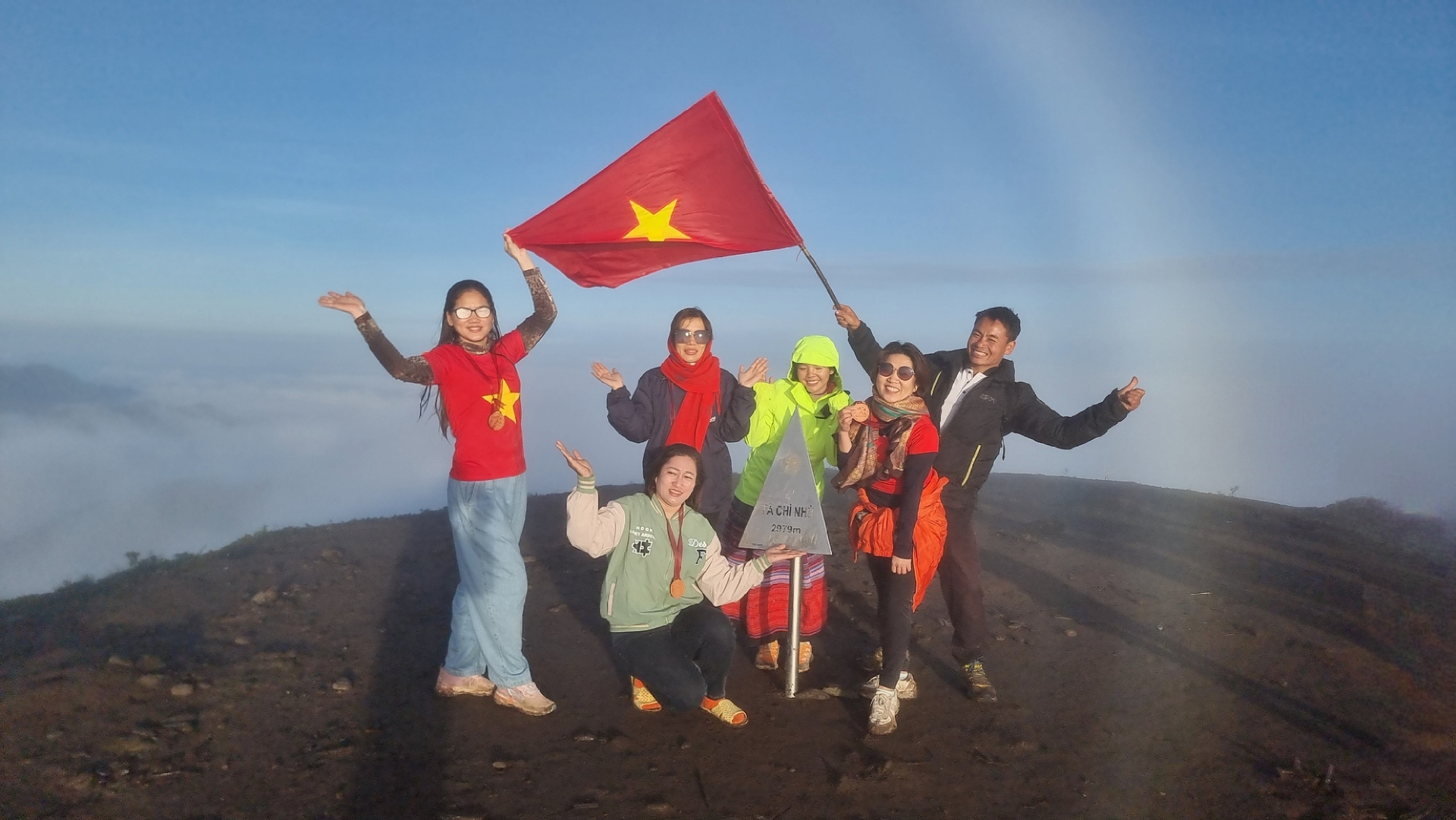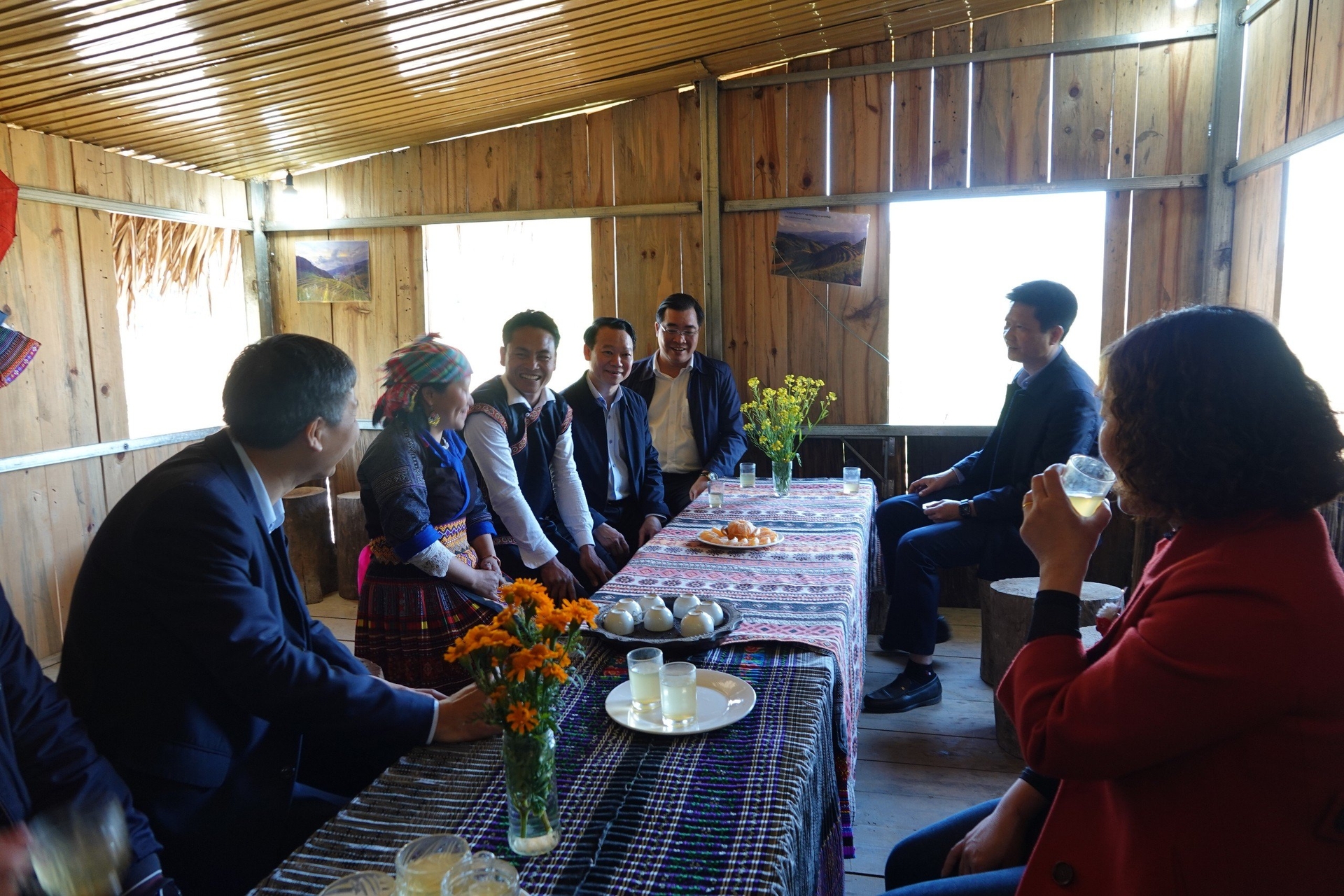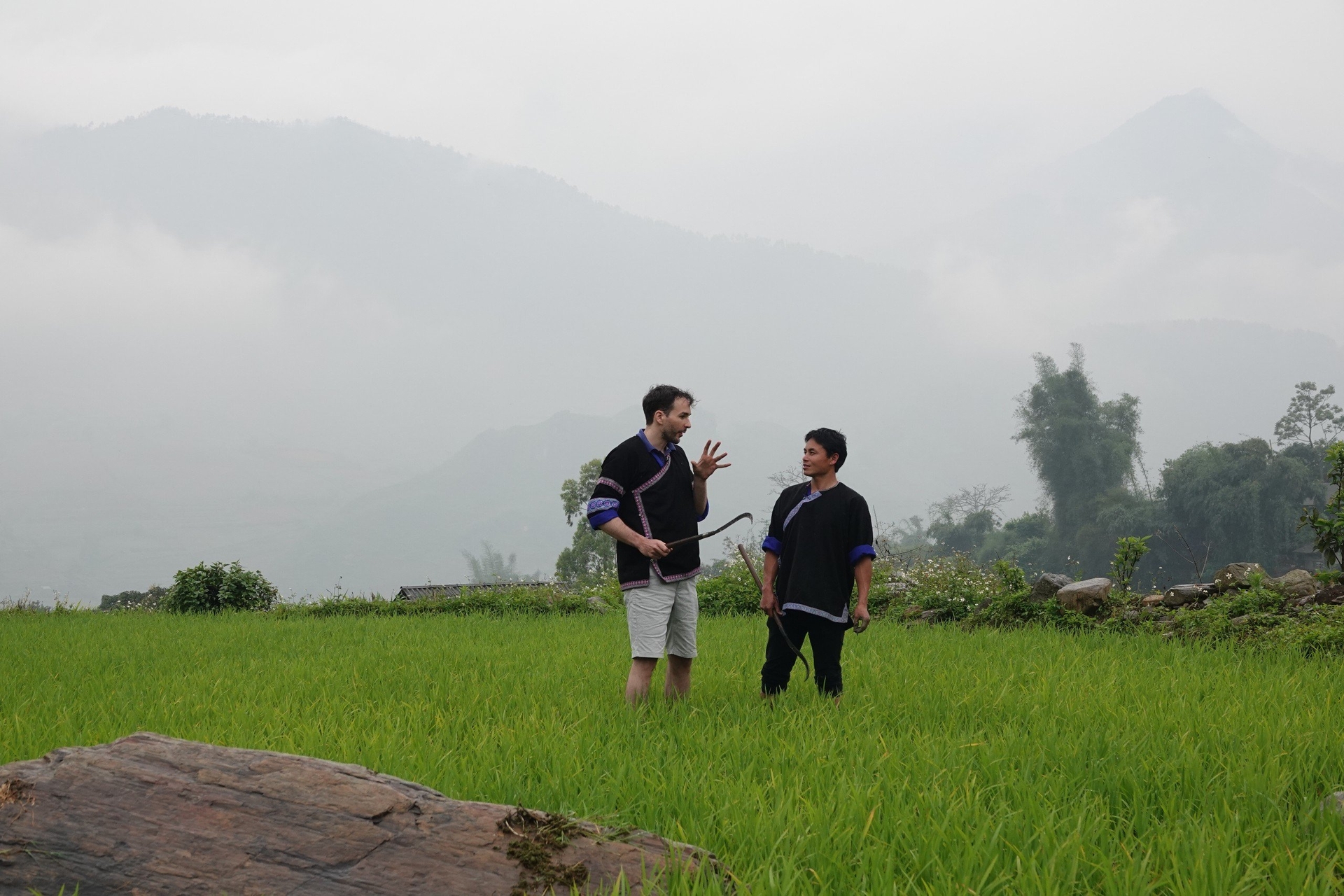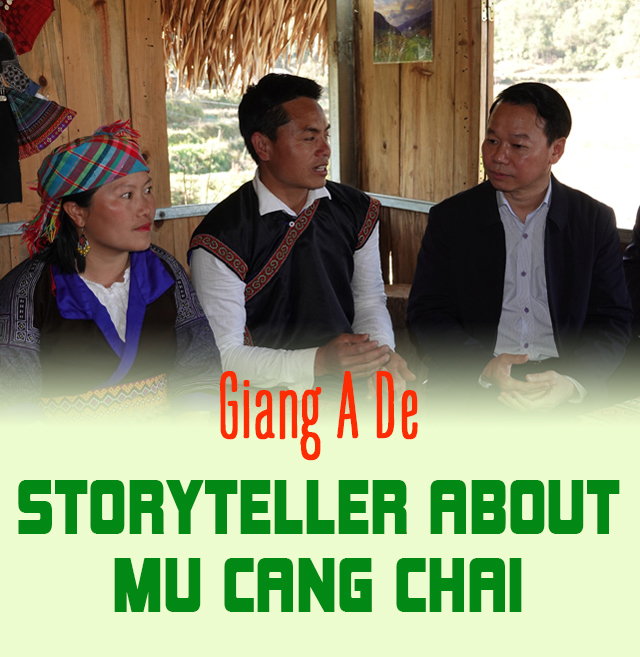Giang A De is not like many young men of the same age. He thinks differently and is changing many villages in the highlands of Mu Cang Chai.
About six years ago, on the day that Giang A De quit his job at a large corporation to start a business with a community tourism model, the Mong people in La Pan Tan said, “Giang, he was taken away by the forest ghost”. But now, that young Mong man who had been "taken away by the forest ghost" is the owner of Hello Mu Cang Chai Tourism and Trading Co., Ltd., which welcomes thousands of tourists every year. The owner of the bungalow and homestay system operates nearly 20 travel tours in the district, such as: experiential tourism, mountain climbing, paragliding, village tours, motorbike riding, fishing, farming, etc.
Giang A De himself was honored with the “Youth Living a Beautiful Life” award by the Youth Union's Central Committee, and his community tourism model was recognized as a 4-star OCOP product. Every time we meet, the first sentence he usually says is: I am a child of Mu Cang Chai, and everything I do comes from the desire to tell stories about the land and people here.


I first met Giang A De during the business trip of Minister of Agriculture and Rural Development Le Minh Hoan to visit and work in Yen Bai around the end of August last year. I still remember clearly that during that trip, I had heard Secretary of Yen Bai Provincial Party Committee Do Duc Duy boast that Yen Bai has two models of community tourism based on natural resources and the cultural identity of the ethnic minority, namely Suoi Giang tea in Van Chan district and Giang A De’s Hello Mu Cang Chai. And indeed, when we went to Mu Cang Chai and directly witnessed how Giang A De changed the community and this land, not only us but also Minister Le Minh Hoan felt surprised and excited. It is truly hard to imagine that, from the change in thinking of the young man born in 1989, the entire highland of La Pan Tan seems to have woken up from a long sleep and is shining day by day.
Giang A. De said that the Hang Xung village where he was born is located on the high hill of La Pan Tan. One day, not too far away, this place was filled with only the darkness of poverty and depraved customs. The lives of people year-round worrying about food and clothing are inherently hard. Like many other highland communes in the poor Mu Cang Chai district, La Pan Tan is located in the core area of the Mu Cang Chai Rice Terraces Beauty Spot, a Special National Monument. Its beauty and majesty are known to everyone, but the people’s lives are still too difficult. Many people sadly call it “poverty in the heart of the beauty spot”. The lives of highland people rely on meager rice fields and corn burnt-over land, so the year of no hunger is their luck. Children at the age of five or seven have to follow their parents to the burnt-over land. It is normal for children to learn how to read and write and then give up.

Giang A De is the first person from Hang Xung to go to university and have a stable job. After getting married and having children, his life would probably pass peacefully with a decent income at Viettel Mu Cang Chai. However, during the weekends, crossing mountains and climbing hills to come back to Hang Xung, admiring the beauty spot, and witnessing the people’s lives, Giang A De thought, “Something must be done. The Mong people in La Pan Tan cannot rely only on terraced fields for one rice crop per year. They cannot only worry about food all year round. The La Pan Tan children have to be at school.” Those thoughts and concerns became more and more pressing, especially when Giang A De repeatedly witnessed "backpackers" being very passionate and interested in the scenery, people, and culture of Mu Cang Chai, but there was no place for them to stay. Therefore, he thought about doing a homestay. That's right. If wishing to change the village and improve the people’s lives, it is mandatory to find a way to keep tourists, not just let them go to admire the terraced fields and then return.
Giang A De discussed that thought with his wife. Surprisingly, Vang Thi Ly said that was something she had thought about many times, but how to do that? Both husband and wife suddenly laughed loudly when recalling the early days of starting their business. At that time, they did not know English and did not know how to start. After thinking for a while, the couple decided to split up. The husband stayed at home to build, and the wife went to Sa Pa to work at restaurants to both learn how to communicate in English and see how community tourism is implemented there. Hello Mu Cang Chai was finally born.

That is the first community tourism model in La Pan Tan, and perhaps also the first in Mu Cang Chai. Initially, they also planned to invite a few more people to do it with them, but knowing the inherent character of their people, who have to see clear results to follow, the couple could only encourage each other to do it themselves first. On the decertified hillside of Hang Xung village, Giang A. De and his wife bring water from the stream to the farm. They built houses and created landscapes, and after a while, the Hello Mu Cang Chai homestay sign was seen to be attached. They both work, perfect, and learn. If they lack money, they borrow. If lacking knowledge and experience, they read books and do research. Even the road on the mountain, about 200 meters long, was made by the couple themselves, who carry sand and gravel from the stream. And very quickly, both Ly and De spoke English very fluently, thanks to the "policy" that if a tourist teaches the homeowner to speak three English sentences fluently, they will get free breakfast. As diligent as the Hmong girls weaving cloth and as persistent as the compatriot boys cutting mountains to make terraced fields, the couple's community tourism model gradually grows and becomes an attractive destination for tourists to Mu Cang Chai.

Meeting Giang A De again this time, he boasted that Hello Mu Cang Chai had become a tourism and trading company of which he himself is the director. The company currently has 8 bungalows, 1 homestay with 5 rooms, and nearly 20 tours of experiential tourism, tourism combined with mountain climbing, paragliding, village tours, motorbike riding, fishing, farming, etc. Director Giang A. De also links and signs contracts with many tour operators and travel agencies and registers accounts at sites specializing in travel such as Booking, Agoda, AinB&B, Expiedia, etc. “And the main thing that makes me happiest is that Hello Mu Cang Chai has inspired and led many Mong people in La Pan Tan to participate in community tourism development,” the person who had been taken away by the "forest ghost" laughed loudly. Vice Chairman of La Pan Tan Commune People's Committee, Mr. Giang A Thanh, also happily revealed: “De and his wife are "raising" seven tour guides fluent in English, 15 Vietnamese tour guides, more than 50 taxi-motorbike drivers, and dozens of porters who specialize in guiding guests to climb mountains.

With the slogan "Going is fun; coming is enchanting", Hello Mu Cang Chai has now truly attracted and conquered tourists when they come to the highlands. In 2019, before the COVID-19 pandemic outbreak, Hello Mu Cang Chai homestay welcomed over 600 guests with a revenue of over VND 250 million. In this year's golden season, that number has reached thousands. “Most tourists come here to look for differences, novelty, and uniqueness in culture, life, and nature to reduce stress. With Hello Mu Cang Chai, keeping a smile and creating friendliness and sociability so that everyone feels happy and full of life energy are hand-in-hand values," Vang Thi Ly held her husband's hand and shared with everyone as a professional tour guide.
In addition to focusing on improving infrastructure to serve tourists, Giang A De and his wife also open English classes for young people in the village and open a free bookshelf called "I Have a Book" for each child in La Pan Tan to all have books. Organize extracurricular exchanges between the young generation of La Pan Tan and foreign tourists. An ecosystem of developing tourism based on natural beauty spots combined with the cultural identity and people of Mu Cang Chai is also gradually forming. Giang A De and his wife also successfully opened and operated mountain climbing tours to Thap Troi Mountain, Ta Chi Nhu, Lung Cung, Mong Ngua Rice Hammock, Mo De Bamboo Forest, etc. They also open classes to teach traditional brocade weaving, Mong flute making, or people’s agricultural tools to sell to tourists.
Along with that are models of livestock farming and cultivation, creating typical pigs, chickens,vegetables, and fruits of the people to serve tourism. Giang A De and his wife also encouraged six Mong households in the village to do a good job of raising cattle, pigs, and chickens, cleaning their houses, and planting flowers from the gate to the campus of each house to do tourism. Every house he went to, he said, “If we only work in the fields to get rice, we will never be better off. We have to work in the fields to serve tourists.” Then he guided the people to take tourists to plow the fields, go to the stream to catch fish, weave brocade, make wine, etc. Only then did the people realize that these things could make money. “People must be the subjects of community tourism,” Giang A. De said, just like a politician.

Giang A. De also established and trained members of the travel taxi-motorbike driver team. Members of the group learn English, learn about the culture and history of the Mong people in Mu Cang Chai, and clearly understand the value of each place and each traditional profession of their people to guide and serve tourists. "Every trip is a story," Giang A. De said. That is the way to impress and keep tourists staying in Mu Cang Chai.
Just returning from a journey leading a group of Portuguese tourists to explore Mam Xoi Hill, Mong Ngua Rice Hammock, Mo De Bamboo Forest, Thap Troi Mountain, etc. Giang A Do, a member of the Hello Mu Cang Chai taxi-motorbike driver team, boasted: “From having no jobs, now, thanks to Giang A De, many young people in the village have a stable income, can study, gain more knowledge, and love their homeland and cultural identity. Do was smiling brightly while Ricardo, a Portuguese tourist, continuously showed his thumb as a “like” symbol, expressing his interest in the land, people, and culture of Mu Cang Chai. Ricardo shared that this is the second time he has come to this highland and clearly sees that Mu Cang Chai is gradually becoming a truly unique, safe, and friendly destination.
Returning to Giang A De, with his contributions to changing La Pan Tan, in 2020, he was honored to be awarded the title of “Advanced Youth Who Follow Uncle Ho's Word” by the Central Committee of the Ho Chi Minh Communist Youth Union. In 2021, he was awarded the title of “Young Living a Beautiful Life Nationwide" and rewarded by many other levels and branches. The community tourism destination "Hello Mu Cang Chai Homestay" has also been recognized as a 4-star OCOP product, the first community tourism product of Yen Bai to be honored.


Talking to Secretary of Mu Cang Chai District Party Committee Nong Viet Yen, he said that Mu Cang Chai today is changing day by day, partly thanks to young breezes like Giang A De.
“With the philosophy of building Mu Cang Chai into a unique, safe, and friendly destination, we identify tourism as the direction and spearhead for Mu Cang Chai to sustainably reduce poverty. Mu Cang Chai's regional planning is oriented towards developing tourism as the focus, based on three factors including climate, natural landscape (terraced fields), and ethnic cultural identities. Young people like Giang A De are contributing to realizing that goal," Mr. Nong Viet Yen affirmed.
The breeze of Giang A De blows on Ly A Do, a Hmong man in La Pan Tan, to do Mam Xoi Hill Tourism Cooperative, blows on Giang A Chinh at Mong Ngua Rice Hammock Tourism Cooperative, and many other young Hmong people. They are awakening Mu Cang Chai every day, awakening and promoting the cultural identity, natural scenery, and beauty of the highland people.

Mu Cang Chai today is like a colorful painting, becoming more and more brilliant. The natural scenery blends with the cultural identity of the people, ecstatic in the drunkenness of the Mong Flute Festival, Gau Tao Festival, To Day Flower Festival, Paragliding Festival, etc. Models of community tourism cultural villages formed with the unique characteristics of the highland people are gradually changing this land.
Saying goodbye to Giang A De, he repeated again and again that the people and their cultural identity are the subjects of development. More than anyone else, they are the ones who conserve, preserve, and promote those values and have the right to inherit them.
“I am just the storyteller of Mu Cang Chai,” smiled Giang A De.

Content: Hoang Anh - Vo Viet
Photo: Hoang Anh
Translated by: Huyen Vu Thu



